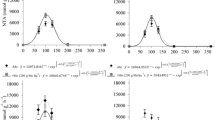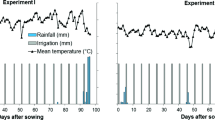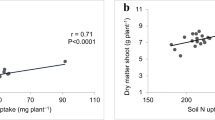Abstract
In 2005 and 2006, 30 and 15 cowpea genotypes were respectively evaluated for plant growth and symbiotic performance at Manga in Northern Ghana, in order to identify N2-fixing potential of these cowpea genotypes as source of N for cropping systems. The results showed differences in biomass production by the 30 or 15 cowpea genotypes. In 2005, cultivars Fahari, Mchanganyiko, IT97K-499-39, IT93K-2045-29 and IT84S-2246 produced the most shoot biomass, while Apagbaala, Brown Eye, ITH98-46, Vita 7 and Iron Grey produced the least. Of the 15 genotypes tested in 2006, cv. TVu11424 produced the largest amount of biomass, and ITH98-46, the least. Isotopic analysis of15N in plant parts also revealed significant differences in δ15N of the cowpea genotypes studied. As a result, the percent N derived from fixation (% Ndfa) also differed among the cowpea genotypes tested in 2005, with only 5 out of the 30 cultivars obtaining over 50% of their N from symbiotic fixation. Whether expressed as mg N.plant−1 or kg N.ha−1, the levels of N2 fixation by the cowpea genotypes varied considerably during 2005 and 2006, with values of N contribution ranging from 14.1 kg N.ha−1 by cv. TVu1509 to 157.0 kg N.ha−1 by IT84S-2246 in 2005. The amounts of N-fixed in 2006 ranged from 16.7 kg N.ha−1 by cv. ITH98-46 to 171.2 kg N.ha−1 by TVu11424, clearly indicating genotypic differences in symbiotic N yield. Re-evaluating 15 out of the 30 cowpea genotypes for N2 fixation in 2006, revealed higher % Ndfa values (>50%) in all (15 cowpea genotypes) relative to those tested in 2005, indicating greater dependence on N2 fixation for their N nutrition even though, the actual amounts of fixed-N were lower in 2006. This was due, in part, to reduced plant biomass as a result of very late sampling in 2006, close to physiological maturity (72 DAP in 2006 vs. 46 DAP in 2005) when considerable leaf matter was lost. The amount of N-fixed in 2006 can therefore be considered as being under-estimated.
Similar content being viewed by others
References
Ahenkora, K., Adu Dapaah, H.K., and Agyemang A. 1998. Selected nutritional components and sensory attributes of cowpea (Vigna unguiculata (L.) Walp) leaves.Plant Foods for Human Nutrition 52: 221–229.
Ayisi, K.K., Nkgapele, R.J., and Dakora, F.D. 2000. Nodule formation and function in six varieties of cowpea (Vigna unguiculata L. Walp) grown in a nitrogen-rich field soil in South Africa.Symbiosis 28: 17–31.
Boddey, R.M., Peoples, M.B., Palmer, B., and Dart, P.J. 2000. Use of the15N natural abundance technique to quantify biological nitrogen fixation by woody perennials.Nutrient Cycling in Agroecosystems 57: 235–270.
Bado, B.V., Bationo, A., and Cescas, M.P. 2006. Assessment of cowpea and groundnut contributions to soil fertility and succeeding sorghum yields in the Guinean savannah zone of Burkina Faso (West Africa).Biology and Fertility of Soils 43: 171–176.
Bergersen, F.J. and Turner, G.L. 1983. An evaluation of15N methods for estimating nitrogen fixation in a subterranean clover-perennial ryegrass sward.Australian Journal of Agricultural Research 34: 391–401.
Bremmer, E., Gehlen, H., Swerhone, G.D.W., and van Kessel, C. 1993. Assessment of reference crops for the quantification of N2 fixation using natural and enriched levels of15N abundance.Soil Biology and Biochemistry 25: 1197–1202.
Carsky, R.J., Singh, B.B., and Oyewole, B. 2001. Contribution of early season cowpea to late season maize in the savanna of West Africa.Biological Agriculture and Horticulture 18: 303–315.
Dakora, F.D., Aboyinga R.A., Yahaya, M., and Apaseku, J. 1987. Assessment of N2 fixation in groundnut (Arachis hypogaea L.) and cowpea (Vigna unguiculata L. Walp) and their relative N contribution to succeeding maize crop in Northern Ghana.MIRCEN Journal 3: 389–399.
Dakora, F.D., Atkins, C.A., and Pate, J.S. 1992. Effect of NO3 on N2 fixation and nitrogenous solutes of xylem in two nodulated West African geocarpic legumes, Kersting’s bean (Macrotyloma geocarpum L.) and Bambara groundnut (Vigna subterranea L.).Plant and Soil 140: 255–262.
Dakora, F.D. and Keya, S.O. 1997. Contribution of legume nitrogen fixation to sustainable agriculture in Sub-Saharan Africa.Soil Biology and Biochemistry 29: 809–817.
Eaglesham, A.R.J., Ayanaba, A., Ranga Rao V., and Eskew, D.L. 1981. Improving the nitrogen nutrition of maize by intercropping with cowpea.Soil Biology and Biochemistry 13: 169–171.
Ehlers, J.D. and Hall, A.E. 1997. Cowpea (Vigna unguiculata L. Walp).Field Crops Research 53: 187–204.
Jasper, K.I. and Norman, N.P. 1983. Nutrient contents of raw and cooked cowpea leaves.Journal of Food Science 48: 1252–1254.
Ncube, B., Twomlow, S.J., Van Wijk, M.T., Dimes, J.P., and Giller, K.E. 2007. Productivity and residual benefits of grain legumes to sorghum under semi-arid conditions in southwestern Zimbabwe.Plant and Soil 299: 1–15.
Nyemba, R.C. and Dakora, F.D. 2005. Identifying suitable arable weeds as reference plants for measuring N2 fixation in grain legumes in Zambia using15N natural abundance.Symbiosis 40: 79–86.
Ofori, F. and Stem, W.R. 1987. Cereal-legume intercropping systems.Advances in Agronomy 41: 41–90.
Ojiem, J.O., Vanlauwe, B., de Ridder, N., and Giller, K.E. 2007. Niche-based assessment of contribution of legumes to nitrogen economy of Western Kenya smallholder farm.Plant and Soil 292: 119–135.
Oyenuga, V.A. 1959.Nigerian Feeding Stuffs: Their Compositions and Nutritional Value. 2nd Edition. University Press, 120 pp.
Pate, J.A., Unkovieh, M.J., Amstrong, E.L., and Sanford, P. 1994. Selection of reference plants for15N natural abundance assessment of N2 fixation by crop and pasture legumes in South-west Australia.Australian Journal of Agricultural Research 45: 133–147.
Pausch, R.C., Mulchi, C.L., Lee, E.H., and Meisinger, J.J. 1996. Use of13C and15N isotopes to investigate O3 effects on C and N metabolism in soybeans. Part II. Nitrogen uptake, fixation and partitioning.Agriculture, Ecosystems and Environment 60: 61–69.
People, M.B. and Herridge, D.F. 1990. Nitrogen fixation by legumes of tropical and subtropical agriculture.Advances in Agronomy 44: 155–223.
Peoples, M.B., Turner, G.L., Shah, Z., Shah, S.H., Aslam, M., Ali, S., Maskey, S.L., Bhattarai, S., Afandi, F., Schwenke, G.D., and Herridge, D.F. 1997. Evaluation of the15N natural abundance technique to measure N2 fixation in experimental plots and farmers fields. In:Extending Nitrogen Fixation to Farmers Fields. Rupela, O.P., Johansen, C., and Herridge, D.F., eds. ICRISAT, Patancheru, India. pp. 57–76.
Platt, B.S. 1962. Tables of representative values of food commonly used in tropical countries.Medical Research Council special report, series 20. MRC, London.
Ramos, M.G., Villatora, M.A.A., Urquiaga, S., Alves, B.J.R., and Boddey, R.M. 2001. Quantification of the contribution of biological nitrogen fixation to tropical green manure crops and residual benefits to subsequent maize crop using15N-isotope dilution techniques.Journal of Biotechnology 91: 105–115.
Streeter, J. 1988. Inhibition of legume nodule formation and N2 fixation by nitrate.Critical Reviews in Plant Sciences 7: 1–23.
Shearer, G. and Kohl, D.H. 1986. N2-fixation in field settings: Estimations based on15N natural abundance.Australian Journal of Plant Physiology 13: 699–756.
Teixera, C.P., Reinert, F., Rumjanek, N.G., and Boddey, R.M. 2006. Quantification of biological nitrogen fixation toCratylia mollis using the15N natural abundance technique in the semiarid Caatinga region of Brazil.Soil Biology and Biochemistry 38: 1989–1993.
Unkovich, M.J., Pate, J.S., Sanford, P., and Amstrong, E.L. 1994. Potential precision of the δ15N natural abundance method in field estimation of nitrogen fixation by crop and pasture legumes in South-west Australia.Australian Journal of Agricultural Research 45: 119–132.
Ssali, S. and Keya, S.O. 1984. Nitrogen level and cultivar effects on nodulation, dinitrogen fixation and yield of grain legumes. I. Cowpea cultivars.East Africa Journal of Agriculture and Forestry 45: 247–254.
Author information
Authors and Affiliations
Corresponding author
Rights and permissions
About this article
Cite this article
Belane, A.K., Dakora, F.D. Measurement of N2 fixation in 30 cowpea (Vigna unguiculata L. Walp.) genotypes under field conditions in Ghana, using the15N natural abundance technique. Symbiosis 48, 47–56 (2009). https://doi.org/10.1007/BF03179984
Received:
Accepted:
Issue Date:
DOI: https://doi.org/10.1007/BF03179984




